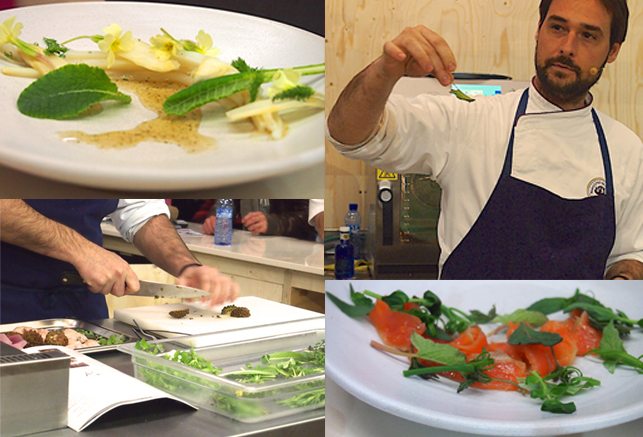
The10th Mediterranean Diet Conference could not have taken place in a more appropriate location than the Alimentaria Food and Drink Trade Fair, which was held in Barcelona earlier his month. Admittedly once the conference started, a huge amount of self-control was needed to walk past the tempting sights, smells and sounds coming from the brightly lit food and drink pavilions. But having arrived a day before the conference, it meant that I was able to whizz around the different areas of the Fair sampling lots of tasty titbits such as jamón serrano, chorizo, olive oil, cheeses and even freshly fried churros- a childhood favourite!
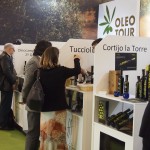
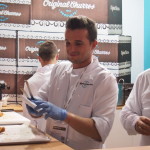
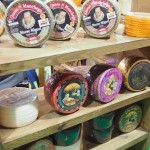
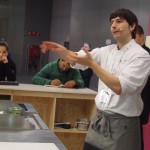
It was also a great opportunity to stop and chat to producers about food trends (like the expansion in organic and health foods) or sample newly launched products. My favourites included the olive oil jelly which was surprisingly sweet and a lycopene infused olive oil for a two-in-one health kick. The taste was a bit like liquid sun-dried tomatoes so would be good in salads or hot dishes like pasta.
I was also able view some of the Spanish celebrity chef demonstrations. It was a real treat getting the chance to see the likes of Sergio Bastard, Oriol Roiura and Miguel Angel de la Cruz, close up and to taste some of their creations. I was struck by their willingness to share their philosophy as well as techniques, reflecting a new attitude to “show and tell” rather than jealously guarding culinary secrets (as was the case with previous generations.) Perhaps this is a result of El Bulli’s influence to democratise kitchen know-how as well as the effects of social media.
My favourite demonstration was by Miguel Angel de la Cruz, as his food is characterised by clever visual puns but whose passion for using freshly picked local ingredients shines through in every dish. La Botica de Matapozuelos, his family restaurant, is located in a small rural village in Valladolid, in a very unflashy part of North-West Spain. The province enjoys a good reputation among food lovers for its local specialities such as suckling pig, veal, black pudding and fine wines.
The Michelin star chef draws on the region’s specialities for inspiration but gives them a unique twist. The first recipe was a trompe l’oeil “cappuccino” using the famous black pudding. Miguel placed the pudding in the bottom of a glass cup and then piped a creamy praline topping made from onion, pine nuts and honey. It did actually look like a cup of coffee! Sadly I did not get the chance to try it but it must have been good as there were lots of appreciative sounds from those in the audience who did!
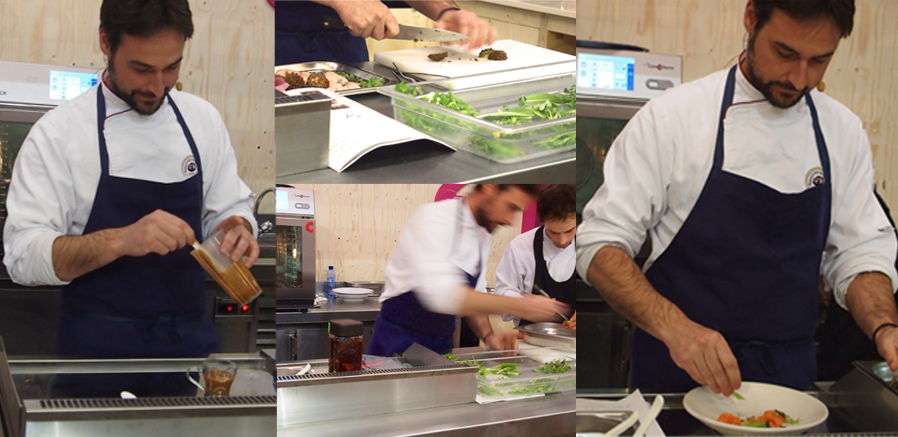
Miguel Angel then spoke of how local wild plants have become part of his signature-especially the pine cones and kernels which are abundant in the area. Many local plants have long been valued for their medicinal rather than culinary properties, which is ironic given that the restaurant is situated in a converted chemist’s (La Botica means Pharmacy in Spanish) The chef is trying to change common perceptions by using the plants for their flavours and colours and has written a book called “El cocinero colector y las plantas silvestres” (The foraging chef and plants from the wild)
I remember being given infusions of this herb as a child whenever I had indigestion (usually after scoffing too much party food!) or if I couldn’t sleep. But I would not have thought of using it in cooking. Miguel however created a yellow syrup which he spooned onto the plate as a silky base for the cooked asparagus. As a finishing touch, he added the heads and leaves of wild yellow Primulas to the fresh looking ensemble. The finished dish looked pretty enough to hang on a wall!
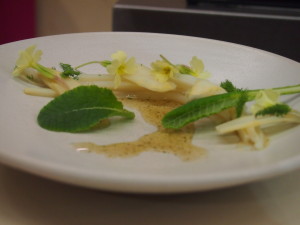 It was surprising to hear about the variety of other plants he finds growing wild, such as chicory, lettuce and spinach, which he combines with local meat or fish to produce healthy, vibrant dishes such as the pink river trout one below.
It was surprising to hear about the variety of other plants he finds growing wild, such as chicory, lettuce and spinach, which he combines with local meat or fish to produce healthy, vibrant dishes such as the pink river trout one below.
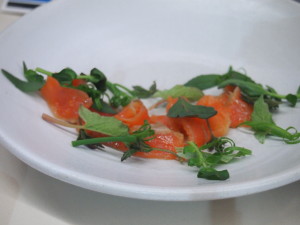
His restaurant has also become known for his inventive use of pine cones. He showed us the mini green cones and said they are as versatile as lemons. “Esto es para mi un limon,” he said (“This is just like a lemon to me.”)
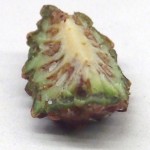
Chopping the cone into quarters, he squeezed one of the pieces until drops of white juice appeared. Miguel explained how by freezing the green cones, then thawing them out, he is able to extract the juice to make marinades, sauces and “jalea”, a type of runny jelly made with the cones, sugar and water. The mixture is placed in a glass jar and left in the sun until it turns into a golden jelly. This then adds a sweet/sour note to dishes, such as the caramelised shallots and thyme below.
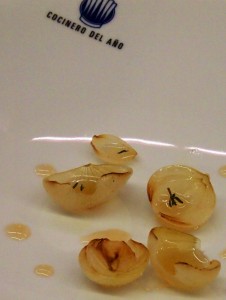
As the show continued, I detected a strong element of fun underlying his cooking. Miguel clearly enjoys surprising his diners by presenting them with dishes that are not what they first seem. Apart from the “cappuccino”, we were shown other clever recipes such as his “Seta Callo” dish (Mushroom Tripe). This was inspired by the sponge-like texture of white seta mushrooms which look like fresh tripe. Tripe is popular in Spain and traditionally eaten in a rich brown sauce. So Miguel added a rich veal stock to the cooked mushrooms to create the look-alike dish. I have never been a tripe fan so his version looked and smelt a lot more appealing!
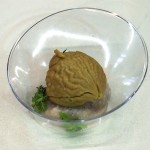
Another creative dish was made by blending fresh chestnuts with foie gras pate. This was then set in a silicon mould which looked like a cooked chestnut when arranged on the plate. It was a fun way of reflecting the ingredients used.
To finish we were given mini sponge cakes, made with local carob beans, to dip into some local red wine. It was palate pleasing but not a show stopper. So instead of a photo of the desert, I have chosen to end this post with his quail and red onion dish. Why? When arranged in layers on the plate, the onion which had been marinated in vinegar, looked just like pink faded rose petals. It drew lots of appreciative comments from the audience. Who would have thought that one of the most common vegetables used in everyday cooking could look so good?
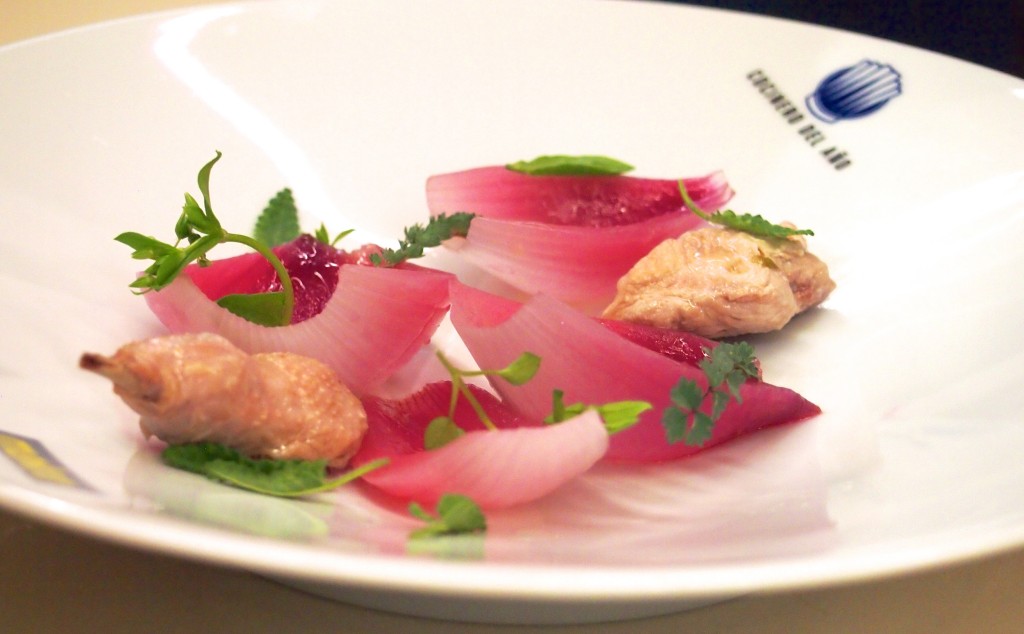

You must be logged in to post a comment.